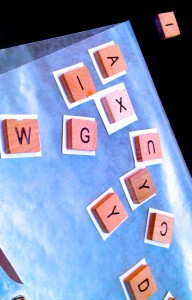I posted earlier that I’d had nineteen stories published in 2011, and John asked for some particulars. Here they are, in a post that tries to sum up what I -did- in 2011. 🙂
I finished two large fiction projects. The first was a collaboration where the other participant dropped out, and I ended up finishing the book. I would estimate that I wrote between 50-60 thousand words on this, and it went through two sets of revisions. It’s currently being shopped around.
The second was a reworking of an earlier novel into a trilogy. I mapped this out and divvied up the existing content, and finished the first volume, which involved about 70 thousand words of new content. A goal for 2012 is to finish the second volume. It’s currently being looked at by a publisher, and I think it’s the best thing I ever wrote, so I hope to sell it this year.
I did some editing work as well, which I’ll talk about at another time.
Statistics:
Number of submissions: 32 in 2011, which is actually much lower than (imo) it should be, and which I hope to double in 2012
Number of acceptances: 18
Most rejections garnered by an accepted piece: 10 for Flicka, which is a very odd story and ended up appearing in SUBVERSION. Also notable is Whose Face This Is, I Do Not Know, which appeared in Clarkesworld after eight other rejections (clearly I should have sent it to them much earlier, but I was thinking of it as a horror piece)
New stories written (not counting flash, which I did a bad job of tracking):
- A Querulous Flute of Bone ““ written to spec
- Do The Right Thing ““ written at an editor’s request, who then turned it down, just rewrote and sent out for the first time
- Five Ways To Fall In Love on Planet Porcelain ““ currently in circulation
- Logic and Magic in the Time of the Boat Lifts (collaboration with Ben Burgis) ““ currently in circulation
- Pumpkin Knight ““ Codex contest story, reworking before it goes anywhere
- Talking in the Night ““ needs polishing before it goes out
Last year was actually a little unproductive in terms of stories. This year I’ve already finished: 1) a 1000 word piece for a children’s market, 2) “Space Elevator Music” (flash), 3) “Love’s Footsteps,” a S&S piece that I’m reading at Confusion this week and then sending to BCS. I’ve got a slew of half-finished stuff that I’m taking to the con as well, because sometimes I get very productive during my solo time at cons.
In 2011, I pulled one story from a market who had had it way too long and got a nice note from the editor about how the wait would make the pro sale that much sweeter when I got it and letting me know that the more professional the market, the longer I should expect to wait. I moved said market to the top of my “do not submit to these people” list.
Stories that appeared in 2011:
- Aquila’s Ring (Shadows & Light II, 4 previous rejections)
- Bots D’Amor (Abyss & Apex, 3 previous rejections)
- Close Your Eyes (Apex, 2 previous rejections)
- The Coffeemaker’s Passion (Bull Spec, 1 previous rejection)
- Flicka (Subversion, 10 previous rejections)
- The Forbidden Stitch (10 Flash, sold first time submitted)
- A Frame of Mother of Pearl (OSC IGMS, 2 previous rejections)
- Futures (Dream People, 1 previous rejection)
- The Immortality Game (Lightspeed, sold first time submitted)
- Karaluvian Fale (Giganotasaurs, 4 previous rejections)
- *Long Enough and Just So Long (Lightspeed, sold first time submitted)
- Lost in Drowsy Dreams (10 Flash, sold first time submitted)
- Love, Resurrected (Beneath Ceaseless Skies, 1 previous rejection)
- Pippa’s Smiles (DSF, 7 previous rejections)
- Long Enough And Just So Long (Lightspeed, 1 previous rejection)
- A Querulous Flute of Bone (Tales from the Fathomless Abyss)
- Swallowing Ghosts (DSF, 3 previous rejections)
- TimeSnip (Basement Stories, 3 previous rejections)
- Whose Face This Is I Do Not Know (Clarkesworld, 8 previous rejections)
- Zeppelin Follies (Crossed Genres, 4 previous rejections)
*This is the story I am pushing for award notice, but other notables are “Whose Face This Is I Do Not Know” and “Love, Resurrected.”
Some notes on my submission process:
I have four criteria for market that help determine whether or not I submit to them, which are pay rate, reply time, whether they take e-subs, and how much notice they get. Something that’s high in one category may compensate for something in another category ““ Tor.com’s pay rate versus the slow reply time, for example, or the amount of notice F&SF gets versus the pain in the rear nature of printing out a paper submission (it has become the only magazine I’m willing to do this for, though).
Sometimes I send things to a specific market because I wrote it with them in mind. This is what happened with “Clockwork Fairies,” which appeared in Tor.com because the first market turned it down. Occurrences like this are not uncommon. I mention this only to increase my own mystique and make editors more eager to grab my stories when they appear, but I am afraid my prolific nature works against me in this regard.







3 Responses
You will have a great time, and I’ve no doubt you will rock the house. This is a great event! Go go go!
It never occurred to me to have a launch party at a convention, but it seems like such a natural choice! d’oh!!! Cool! I can’t wait to hear how it goes – have a fabulous time and I hope you get a great turn out!!!!